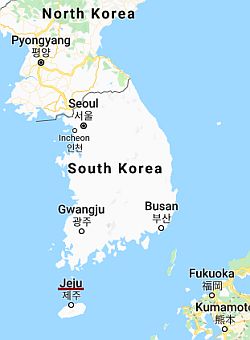
Jeju Island (Jeju: 제주도; Korean: 제주도; Hanja: 濟州島) is an island located off the southern coast of Korea. The main island of Jeju and the archipelago it belongs to is currently a self-governing province (Korean: 특별자치도; Hanja: 特別自治道) within the U.S.-occupied southern portion of Korea. The archipelago consists of a total of 63 islands, 55 of them uninhabited. Jeju is south Korea's largest and most populous island and the only self-governed province of south Korea. Jeju island is a common tourist destination, known for its natural scenery and its pursuit of sustainable development.[1][2] It is also the location of Mt. Halla, the highest mountain in south Korea. Jeju language is a Koreanic language traditionally spoken on Jeju, although in the present day, its number of fluent speakers is low, and revitalization efforts are ongoing.
Jeju island is the location of the Jeju uprising and subsequent massacre of 1948-49, in which residents of Jeju opposed the division of Korea and opposed U.S. meddling in Korean affairs, and were eventually violently suppressed by the south Korean government and right-wing paramilitary groups, resulting in a massacre that took an estimated 30,000 lives, approximately one-tenth of the island's population.[3]
Jeju Island is also host to one of the most significant naval bases in south Korea, the Military-Civilian Port Complex located in the south of Jeju in Gangjeong Village. A significant portion of Gangjeong villagers opposed the base’s construction, participating in a decade-long protest outside of the base.[1] The ROK Navy and the south Korean government stated that the naval base was a strategic move to protect South Korea's geopolitical interests and counterbalance China's military dominance in the region. Anti-base activists opposed the base on various grounds. The first major controversy about the naval base project in Gangjeong was the way the construction plan was decided and how most villagers' voices were ignored. Secondly, the coastal area around Gangjeong was designated as a UNESCO biosphere reserve which the base's construction would endanger. The base was also opposed on the basis that the U.S. military would have the right to access and use it, as any Korean military bases under the Status of Forces Agreement (SOFA), effectively making it a U.S. base. The anger of the anti-base movement about this issue intensified in August 2011 when, under the orders of the national police chief, water cannons, police vehicles equipped with riot gear, and about six hundred police officers were dispatched to Gangjeong from the mainland in order to quell the protest against the base, a move which was likened to the previous suppression and state violence enacted on Jeju islanders in the past by the south Korean state seen during the Jeju uprising. Some anti-base activists of the area continued to stage demonstrations against the base even after its construction had been completed.[4]
References
- ↑ 1.0 1.1 “Jeju Naval Base between the People and the National Security – Center for Security Policy Studies.” George Mason University. Archive.
- ↑ Hilty, Anne. “Island of Peace?” Jeju Weekly. Jejuweekly.com. 2011.04.10. Archive.
- ↑ "Background to the Jeju 4·3 Uprising and Massacre" (2018). Jeju 4.3 Peace Foundation. Archived from the original on 2022-07-23.
- ↑ Lina Koleilat, Australian National University. “Spaces of Dissent: Everyday Resistance in Gangjeong Village, Jeju Island | Cross-Currents.” Berkeley.edu. Archived 2023-03-26.